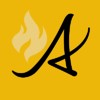
WILDFIRE DANGER
The wildfire danger is HIGH for south of Lake Athabasca and VERY HIGH for north of Lake Athabasca within the Fort McMurray Forest Area. Fort Smith's fire danger is considered EXTREME. Please be very cautious when recreating outdoors as we are entering a drying trend where wildfires can ignite easily and spread quickly.
Report wildfires immediately by calling 310-FIRE (3473).
EVACUATION ORDERS
Highway 5 is currently closed due to wildfire activity. Click here, for more highway closure information.
For more information on the wildfire situation in Wood Buffalo National Park, click here
The Regional Municipality of Wood Buffalo (RMWB) has declared a state of local emergency and issued an evacuation order for the community of Fort Fitzgerald. Click here for more information.
The Chief and Council of Smith's Landing First Nation has declared a state of local emergency and issued an evacuation order. Click here, for more information.
The Town of Fort Smith has declared a state of local emergency and issued an evacuation order for residents within the municipality and surrounding areas. Click here, for more information.
For information on Northwest Territories evacuations click here.
For more information and related links, please see MNZ003 below.
SMOKY CONDITIONS
Due to the numerous wildfires in Alberta and other parts of Canada, smoky conditions will continue. Anyone with health concerns should visit Alberta Health Services or call 811 for health advice from Alberta Health Link. Before travelling check www.511.Alberta.ca for information the latest road conditions or closures. Visit www.firesmoke.ca to see where the smoke is coming from and to view wildfires on a map, download the AB Wildfire App or visit the Alberta Wildfire Status Dashboard.
WILDFIRE OF NOTE
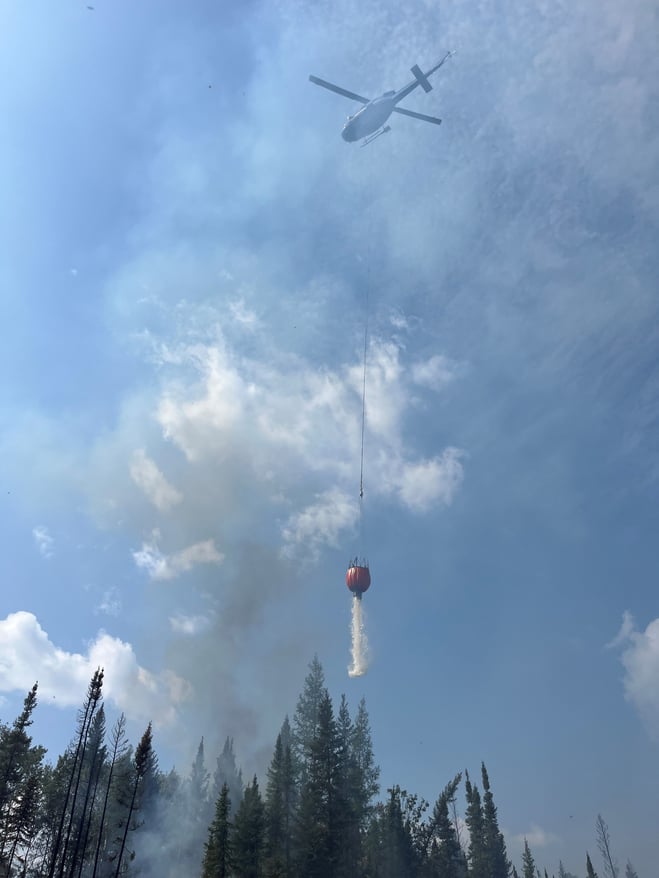
Helicopters continue to bucket along key locations on the north flank of the Wood Buffalo Complex (August 21, 2023).
Wood Buffalo Complex (previously Parks Canada Fire 7, Alberta Wildfire MNZ003, and NWT SS069):
To see the evening update, click here.
If you have evacuated, DO NOT return. This is an active wildfire operation area and is dangerous for residents and first responders if people start coming back before its safe. Extreme fire behaviour was seen yesterday and is expected to continue for several days due to the weather forecast.
The Wood Buffalo Complex is managed using Unified Command with the Government of Northwest Territories, Parks Canada, and Alberta Wildfire.
Wood Buffalo Complex is currently 453,012 hectares in size and is classified as OUT OF CONTROL. At its closest, it is still approximately 4 km south of Fort Smith, NWT. Despite the overall fire growth, there was no significant growth towards Fort Smith last night. We recognize that this distance has not changed in the last week or so and we would like to stress that this is not an indication that the fire is not growing or that the threat is gone. Crews have worked tirelessly along the northern flanks with helicopter bucketing, dozer guard strengthening and direct attack to try to stop the spread towards communities.
Yesterday, the wildfire made progress towards Fort Fitzgerald, AB, breaching the more southerly of two fireguards and is now approximately 3.5 km from the first structure in town. Structural protection sprinkler systems were turned on in Fort Fitzgerald prior to the fires arrival.
Collectively, there are 308 personnel, which includes 57 pieces of heavy equipment and 24 helicopters responding to the Wood Buffalo Complex today.
Weather:
Today, the forecast calls for 24 C and a relative humidity of 30 per cent. Winds are expected to come from the north at 10km/h, gusting up to 25 km/h.
Tomorrow, the forecast calls for 24 C and a relative humidity of 30 per cent. Come Thursday evening, winds are forecasted to be from the northeast 10 km/h, gusting up to 15 km/h. Wind direction is expected to change to coming from the southeast into the night.
Today’s Objectives:
Crew members will use direct and indirect suppression strategies and established structural protection equipment where possible. The management team is also looking for the opportunity of planned ignitions to reduce the availability of fuels whenever safe working conditions allow. The crew continues to maintain and improve already established structure protection systems.
Ignition Operations:
Yesterday’s Ignition: The ignition operation that was completed yesterday requires a few more areas to be burned, so that is planned to be finished off early this morning.
Today’s Ignition: Additionally, we are planning an ignition operation east of the Fitz Slough to the Slave River:
Where? Should conditions allow, this operation will take place on the east side of the Fitz
Slough to Hay Camp Road near Ryan Island.
When? Based on current and forecasted weather conditions, we are planning an ignition operation for early this afternoon today, if conditions allow.
What and Why? Ignition is a tool we use to remove fuel from an area during favourable weather conditions so that the wildfire can’t burn there later. Removing the fuel now creates a fire guard that will be helpful for when wind and weather conditions could have otherwise caused increased fire behaviour.
Who and How? We will have helicopters ready to bucket to ensure the dozer guard holds, as well as structural protection equipment up and running on the east side of Hay Camp Road. Ignition operations are only conducted under the watchful eye of experienced wildfire managers and only during optimal conditions.
Work Completed and Yesterday’s Fire Activity:
Thebacha
- Yesterday, we saw the fire cross Connie’s road again, and this time because of extreme drought conditions and unfavourable wind direction, it is now only 6.2 km from Thebacha.
- Crews turned on structure protection equipment and pulled out of the area to ensure crew member safety.
- Over the past days, helicopter bucketing has been happening throughout this area.
- Approximately 10 km of dozer guard has been completed along the fire line south of the Thebacha and Highway 5 junction, working east towards Pine Lake Road.
Bell Rock Subdivision
- The fire is currently 2.8 km away from Bell Rock.
- There has been no new work or fire behaviour in this area.
- A dozer guard was established around the subdivision of Bell Rock on the south side of Highway 5.
- An additional dozer guard was established on the west side of Bell Rock, north of Highway 5.
- Crews also strengthened the containment line that is currently south of Highway 5 and south of Bell Rock. They are continuing to do this work east towards Fort Smith.
- Yesterday, structure protection work was completed.
Fort Smith
- The fire is currently 4 km from Fort Smith.
- Yesterday, the fire growth closest to Fort Smith was able to be slowed for now but did show active fire behaviour at the finger closest to town. Helicopters were immediately bucketing the area into the evening to keep it at bay.
- Upgrading of the old Fort Smith community guard has been completed and is now a 15 blade wide (100 m) guard that has been scraped down to mineral soil. This community guard extends from West 40 (on Highway 5) to Pine Lake Road, just south of Border Town.
- Airport Guards- Dozer guards have been constructed extending south, north, and west of the airport. The western guard connects to the nuisance grounds. The southern guard is connected into Fort Smith community guard.
- Structure protection has been installed at the airport fire camp.
Extensive additional work has been done around town for sprinkler systems and FireSmart work. For more information on these efforts, see the Fort Smith Protective Services Facebook page.
Border Town
- The fire is currently 5 km away from Border Town.
- There has been no new work or fire behaviour in this area.
- A fire guard was established along the powerline and along Kaeser’s Canal.
- Sprinkler lines have been set up along Kaeser’s Canal.
- An additional dozer guard was established from the edge of the Fort Smith community guard to Highway 5 towards the golf course.
- Structure protection has been installed at the field of dreams fire camp.
Fort Fitzgerald
- As previously mentioned, the fire has come closer to town with yesterday’s fire activity after breaching the most southerly fireguard. The fire is now 3.5 km from town.
- Today dozers will work to strengthen the perimeter of the fire that had breached the southerly guard. This will allow us to re-establish protection from the south.
- Yesterday two pumper trucks were positioned in Fort Fitzgerald ready to operate if the fire had reached the town.
- Structural protection sprinklers were turned on yesterday and the day before.
Pine Lake Road
- The fire jumped over Pine Lake Road and was burning on either side of the bridge near Salt River day use area. Structural protection was turned on.
State of Emergency:
The Town of Fort Smith and Fort Fitzgerald have declared a STATE OF LOCAL EMERGENCY and it remains under an EVACUATION ORDER. The ORDER has been issued for public safety.
Highway 5 is currently closed from Hay River to Fort Smith due to safety concerns and limited visibility. Click here for highway closure information.
Frequently Asked Questions:
Did the fire get closer to Fort Smith?
The north fire line remained almost unchanged. But active fire behaviour was seen so helicopters and crews continue to work along this line to bucket and clear the area. That being said, the fire did grow in several other areas of the complex, including towards Fort Fitzgerald and Thebacha.
The forecast shows winds from the north, what does that mean as far as fire behaviour?
Although the winds from the north do give us slight breathing room as far as immediate encroachment to communities, these forecasts indicate active fire behaviour on the southern edges of the complex. Forecasted wind for Friday and Saturday show wind coming from the south along with crossover conditions. The team is expecting a very hard week and are looking at options for planned ignition to clear fuels along the northern fire line to pre-emptively burn under favourable conditions before winds blow towards communities again as forecasted. Given the extremely high drought codes all fuel is burning. We are staying aware of that and taking that into consideration when planning operations.
How does structure protection work?
Structure protection is a sprinkler system that is set up on the top of buildings or any structures you’re intending to protect and uses a pump to run water through the sprinklers. Depending on the pump, it can usually run for about 12 hours before it needs a fuel refill. Structure protection crews will turn pumps on hours before they think a wildfire could get there to raise the humidity in the area around the protected structure, which will limit fire growth towards the structure. Then once a wildfire has burned around the structure, crews will usually leave it up until they are sure there is no more of a wildfire threat to the structure.
This is not the time to come home, If you return, you are directly impeding operations that are working to protect your community.
Please see the town of Fort Smith website for information on the evacuation order.
Please DO NOT return to the area until the evacuation order has been lifted.
Additional Information
For additional information on the efforts being done in the Town of Fort Smith visit their protective services facebook page or the Town of Fort Smith webpage.
For information on all other wildfires visit the respective webpages:
- Wood Buffalo National Park wildfire updates
- Northwest Territories fire information
- Alberta Wildfire Status Dashboard
For up-to-date road conditions, visit GNWT Highway Conditions
Report any wildfires or suspicious smoke in Alberta to 310-FIRE, in Northwest Territories to 1-877-NWTFIRE, and in Wood Buffalo National Park to 867-621-0136.
FORT MCMURRAY WILDFIRE UPDATE
Since January 1, 2023 there have been 58 wildfires in the Fort McMurray Forest Area, burning a total of approximately 326,072 hectares (ha).
MWF021 was detected on May 27 and is located approximately 38 km south of Wood Buffalo National Park. This wildfire is classified as under control (UC) and is 14,760 ha in size. This wildfire was caused by lightning.
MWF023 was detected May 28 and is located near Birch Mountains Wildland Provincial Park. This wildfire is classified as under control (UC) and is 54,639 ha in size. This wildfire was caused by lightning.
MWF024 was detected May 28 and is located east of Marguerite River Wildland Provincial Park. This wildfire is classified as under control (UC) and is approximately 28,454 ha in size. This wildfire was caused by lightning.
MWF025 was detected May 28 and is located approximately 7 km north of Fort Chipewyan. This wildfire is classified as being held and is approximately 95,491 ha in size. This wildfire was caused by lightning.
This wildfire no longer poses a threat to the community of Fort Chipewyan, Allison Bay, Dog Head, or the Fort Chipewyan airport. Eighty per cent of the entire wildfire perimeter is controlled, which includes the entire south perimeter.
MWF026 was detected May 28 and is located northeast of Marguerite River Wildland Provincial Park. This wildfire is classified as under control (UC) and is approximately 1,705 ha in size. This wildfire was caused by lightning.
MWF030 was detected on June 4 and is located near La Butte Creek. This wildfire is classified as being held and is 7.4 ha in size. This wildfire was caused by lightning.
MWF038 was detected on June 29 and is located approximately 6 km north of the Slave Lake/Fort McMurray Forest Area border. This wildfire is classified as under control (UC) and is approximately 569 ha in size. This wildfire was caused by lightning.
MWF039 was detected on June 29 and is located within Birch Mountains Wildland Provincial Park but has crossed over into the Slave Lake Forest Area. This wildfire is classified as under control (UC) and is approximately 15,200 ha in size. This wildfire was caused by lightning.
MWF043 was detected on June 30 and is approximately 20 km southeast of Fort Fitzgerald. This wildfire is classified as being held and is approximately 108,555 ha in size. This wildfire was caused by lightning. To view actual locations of the wildfire, visit the wildfire dashboard.
This wildfire is experiencing decreased fire growth and is not currently moving any closer to Fort Smith or Fort Fitzgerald.
Mutual-aid wildfires:
ANT003 (SS022) was discovered on July 5, 2023 and is located approximately 25 km north of Fort Smith. It is approximately 85,584 ha in size and is classified as out of control. To view a digital map of this fire click here, or to see all fires around Fort Smith and Fort Fitzgerald, click here.
This wildfire is experiencing decreased fire growth and is not currently moving any closer to Fort Smith or Fort Fitzgerald.
Currently, all resources have been pulled from this wildfire to assist with MNZ003 (please see more information below).
MSZ001 is located on the Alberta/Saskatchewan border, just south of Lake Athabasca. This wildfire is classified as being held and is approximately 75 ha in size.
MNZ001 is located on the south edge of the Alberta/Wood Buffalo National Park border. This wildfire is classified as being held and is approximately 2,595 ha.
PROVINCIAL WILDFIRE UPDATE
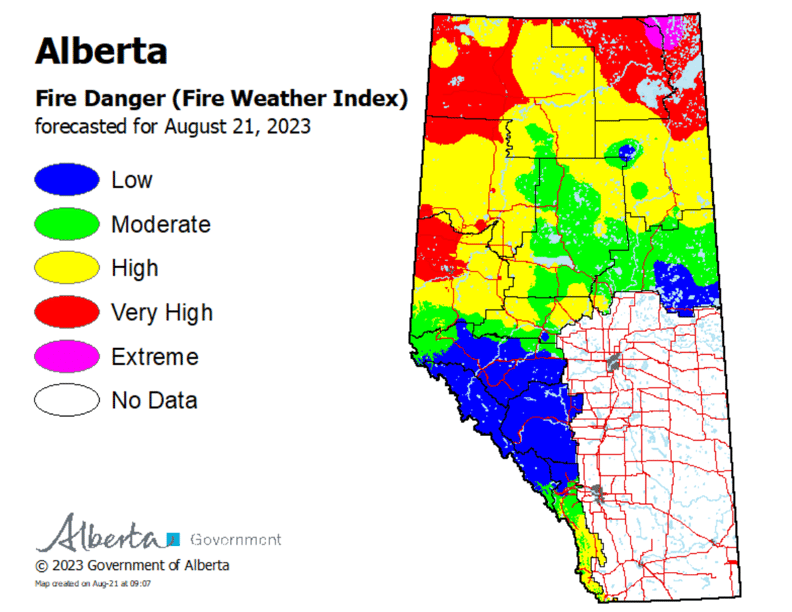
To see the forecasted fire danger click here, updates daily at 3:00 PM.
ON ALERT
Fire lookouts are on high alert constantly watching for smoke and firefighters in helicopters are assessing potential sightings of wildfires, ready to respond to any new wildfires that may start.
Wildland firefighters urge everyone to be extremely cautious when out in the Forest Protection Area. Check your winter burns, and comply with fire bans and OHV restrictions.
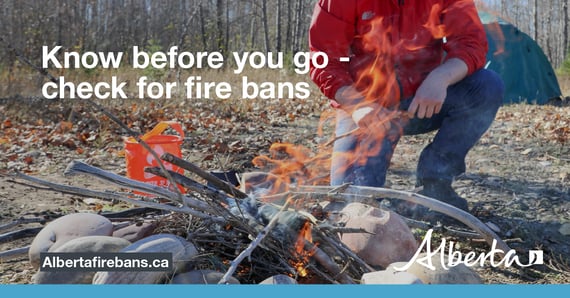
CAMPFIRE SAFETY
Remember to check www.albertafirebans.ca for fire advisories, bans or restrictions in your area or destination. If you are camping in a provincial or national park, check the rules and guidelines and be sure to follow them for your safety and the safety of other campers.
Safe wood campfires - should be within a metal, brick, or rock fire ring.
They are required to:
- be on rock, gravel, sand, or another non-combustible surface that extends at least one metre around the fire
- have a responsible person in attendance to keep fire under control at all times and extinguish before leaving
- have enough water on hand to extinguish the fire. Safe wood campfires on private lands include private land campgrounds and private land recreation areas.
Always let the fire burn down before you plan to extinguish it. Spread the embers within the fire pit, then add water or loose dirt and stir. Repeat until your campfire is cool to the touch. You should not be able to feel any heat from the ashes.
OHV SAFETY
If you plan on riding OHVs in the Forest Protection Area of Alberta, you can reduce the risk of your vehicle causing a wildfire by following these simple steps:
- Before you ride, clean out hot spots and remove debris from your machine.
- After riding through muskeg or tall grass, stop and remove any build-up from your machine.
- Carry firefighting equipment such as a small shovel, collapsible pail or fire extinguisher.
- Wash your OHV and keep it clean; do not wash in streams and creeks.
- Make sure your muffler and spark arrestor are working properly.
- Stop frequently. Take the time to knock debris from your machine’s hot spots. If the debris is smouldering, soak it, stir it, and soak it again to make sure it is extinguished.
For more information, see Off-highway vehicles: Wildfire prevention tips.
EXPLODING TARGETS AND FIREWORKS
The Forest and Prairie Protection Act and associated regulations applies to the shooting, ignition or detonation of exploding targets and fireworks on public lands and private lands located within the FPA.
A Forest Officer from the local forest area office may grant written permission to shoot, ignite or detonate exploding targets or fireworks in the FPA. Written permission of exploding targets and fireworks is based on current wildfire danger and managed on a case-by-case basis.
A fire advisory, restriction, ban or forest closure may prohibit or limit use of exploding targets and fireworks during high wildfire hazard situations within the FPA. Check Alberta Fire Bans or the mobile phone app for the latest information.
WILDFIRE DASHBOARD
The wildfire dashboard provides up-to-date wildfire information at the click of a button. This interactive tool displays important statistics on the number of active wildfires in the Forest Protection Area of Alberta, sizes, locations, suspected causes and more.
The dashboard builds on the former wildfire status map by displaying the most frequently accessed information in one convenient location.
CONTACT
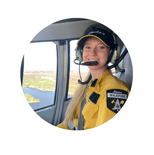
Websites:
Alberta Wildfire, Alberta Fire Bans, FireSmart in Alberta, Alberta Emergency Alerts, Air Quality Health Index
Wildfire Smoke and Your Health, 511 Road Reports, and Emergency Preparation.
Social Media:
Join the conversation on
Apps:
Alberta Wildfire App for Apple or Android and Alberta Fire Bans App for Apple or Android.
